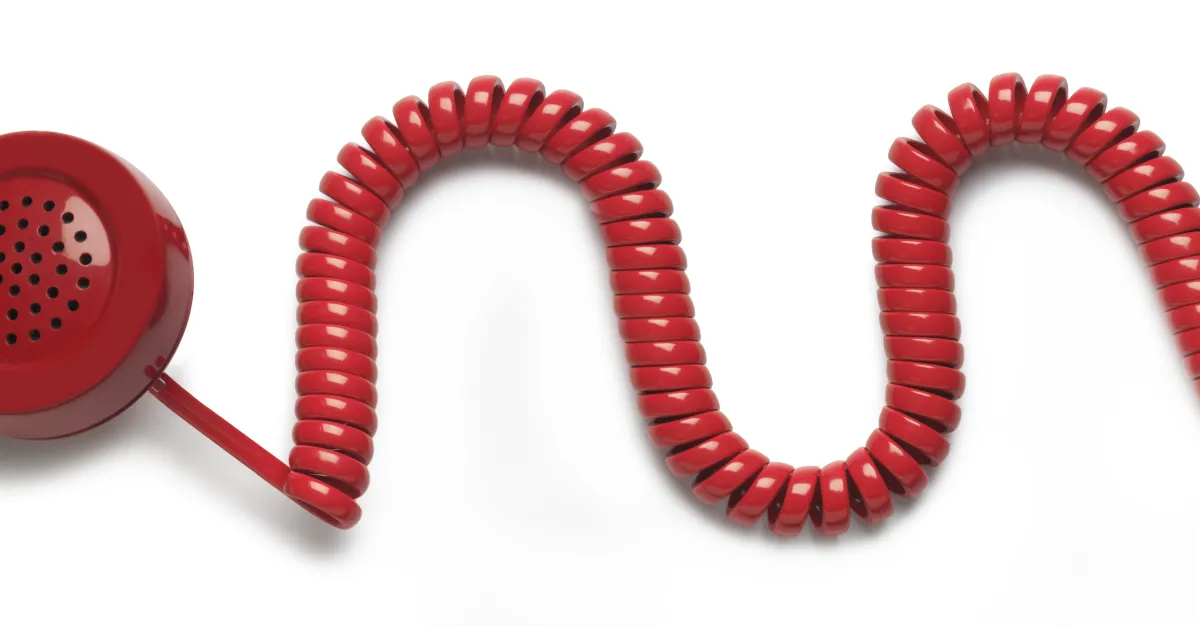
This story originally appeared in Kids Today, Vox’s newsletter about kids, for everyone. Sign up here for future editions.
A few days ago I talked to Ava, an Indiana fifth-grader, on the phone.
I mean the phone phone — Ava’s dad recently installed a landline for her, and she chatted with me using the handset, sitting in her family’s upstairs hallway. “I’m holding it in my hand up to my ear and it’s connected to a base,” she told me, an explanation that would have seemed unnecessary a few decades ago but that is needed now.
Unlike on a FaceTime call, “I’m just hearing audio instead of a person that I can look at,” Ava said. The audio quality was noticeably good.
Ava’s dad, newspaper publisher Chris Hardie, decided to get the phone this spring as an alternative to a mobile device. “Access to social media and the kind of social experiences that those bring are going to be hard and complicate life in all sorts of ways,” Hardie told me. “We’re going to try to wait as long as we can.”
Hardie is one of a growing number of parents around the country turning to landlines for their kids. Tin Can, a company launched last year that offers landline-style phones aimed at children, now has customers in all 50 states as well as Canada, co-founder Chet Kittleson told me.
I understand why parents choose landlines: The phones are often a way to let their kids talk to friends and family without the social and mental-health concerns some associate with smartphones. “I really wanted to give myself and other parents something they can just always say yes to,” Kittleson said.
What’s in it for kids, though? Hearing about the potential resurgence of landlines made me curious whether these older phones were just a worse version of something kids want, or whether the landline itself has its own, organic appeal. After all, landline phones are one of a handful of older technologies that have retained a place in kid culture long after most adults stopped using them; the play phone, complete with handset and buttons (or sometimes rotary dial) remains a fixture in daycares and preschools. Do kids know something we don’t about the pleasures of a retro device?
A low-pressure introduction to the world of phones
Worries over the impact of smartphones on kids have ramped up over the last few years, especially after the 2024 publication of Jonathan Haidt’s The Anxious Generation, which argues that the devices are hampering children’s social and psychological development. Researchers have yet to clearly show links between social media use and mental health problems in kids, but 45 percent of teens themselves now say they spend too much time on social media apps, and there’s a growing desire among parents and educators to give kids more time off their phone.
That desire has engendered efforts like Wait Until 8th, in which families pledge not to get their kids a smartphone until the end of eighth grade (the idea is that if families band together, the smartphone-free kids won’t feel left out). Some parents are also getting their kids smartwatches or flip phones to help them communicate without all the functionality (and, presumably, distractions) of more advanced devices.
The landline is, perhaps, the natural next step in this progression — The Atlantic recently called it “the dumbest phone.” “There’s no apps, there’s no advertisements, there’s no games,” Kittleson said. “There’s nothing for them to do other than connect with another human.”
The Tin Can, which looks just like an ordinary landline from decades past, retails for $75 and plugs into a router or ethernet port (a wifi-enabled model is coming soon). But some parents have gone an even simpler route. Hardie, for example, bought “the cheapest push-button phone I could find” on Amazon — he thinks it was $14.
He looked for a version of the transparent phone he’d had as a kid, but noted that these now command high prices on Etsy and eBay, perhaps because of widespread phone nostalgia.
The phone has been “a fun experiment” for Ava, Hardie said. “When the phone rings, she can hear it from anywhere in the house,” he said. “She’ll drop whatever she’s doing and run to pick it up.”
Getting a call on a landline definitely has a different feel from seeing a name pop up on your smartphone. When she hears the phone ring, she gets “excited and also kind of nervous because I don’t know most of the time who’s calling,” Ava said.
Hardie set the phone up so that only known numbers can call, which means Ava has to write down her friends’ numbers at school and bring them home on scraps of paper.
“I’m excited that they’re going to be able to call me, but it’s also kind of cringe,” Ava told me of this process. Asking for someone’s number like that is “not something I would do if I had a cell phone.”
The advantages of an old-school landline
Parents and experts praise landline phones for their potential impact on kids’ communication abilities. “The landline has the huge advantage of really focusing the child just on the conversation and their imagination and what they want to say,” Sudha Swaminathan, director of the Center for Early Childhood Education at Eastern Connecticut State University, told me.
“Hearing her develop the skills to keep the phone conversation going is exactly what I wanted to come out of the experiment,” Hardie said of Ava. “This is a good life skill to have.”
The actual impact of smartphones on kids remains an area of active debate — my colleague Adam Clark Estes, for instance, has written about the case for giving phones to kids as young as 3 (with limited functionality and a lot of guardrails). It’s far from clear yet whether landlines, pledges, or other efforts to keep kids away from mobile devices will result in better social skills or mental health down the line.
For kids, however, some of the fun of a landline may be more primal. The moment Kittleson set up a landline in his house, even before it worked, his kids “just constantly were playing with it,” he told me. The appeal of the device “is very tactile,” he said: “the buttons, the way they press, the way they click.”
My children have also been known to play with the old landline phone on the wall of our apartment, even though it’s not connected to anything. Growing up, my brother loved phone cords so much that my parents bought him one — just the cord, that is.
“I cannot tell you the number of cords I had shipped to me” during the Tin Can development process, Kittleson told me. “I was playing with color and texture and how boingy they were.”
Smartphones do a lot of things, but they are definitely not boingy, and landlines may satisfy a desire for more hands-on experiences that adults have been experiencing for years now. They’re also part of a larger trend toward retro tech among younger Americans — BlackBerries, photo albums, and cassette tapes have all had a resurgence in recent years as Gen Z consumers seek to recreate a more analog past. At The Cut, Cat Zhang recently wrote about the pleasures of installing a vintage phone in her first solo apartment.
It makes sense that kids, too, would be interested in technological nostalgia, experts say, since they’ve long been interested in toys and games that mimic the past. They may not have been around when landlines were commonplace, but that doesn’t stop children playing with, for example, “kitchen sets that simulate cooking over a log fire” — a common toy in preschools, Swaminathan said.
Kids Today
A newsletter about kids — for everyone, from senior correspondent Anna North.
Email (required)
By submitting your email, you agree to our Terms and Privacy Notice. This site is protected by reCAPTCHA and the Google Privacy Policy and Terms of Service apply.
These sets are usually very appealing to kids, who are naturally curious and want to investigate something that seems new to them, Swaminathan said — even if the technology is actually old.
Ava, for her part, says her friends “think it’s really cool that I have a landline” because “they think it’s kind of old-timey.”
She does wish her phone could text, because her friends are talking about starting a group chat. But she says that while she’ll definitely want a smartphone in the future, she’s okay with not having one for now.
There is a device she does want, though. “There’s one type of phone that has a spinning dial thing,” she told me. “I just think that would be kind of cool.”
What I’m reading
This is more “what I’m writing,” but I am also a novelist, and my next book, Bog Queen, comes out on October 14. It is a literary murder mystery in which the victim is a 2,000-year-old bog body. It is not strictly kid-related, although there is a teen who plays a pivotal role! You can preorder here.
PBS classic Reading Rainbow is coming back as a digital series on YouTube, with librarian and popular TikTok personality Mychal Threets as host.
Schools are cutting nutrition and health programs thanks to President Donald Trump’s “big, beautiful bill,” which eliminates a stream of SNAP funding meant for education. One nonprofit leader called it “a catastrophic situation for public health nutrition.”
My older kid recently finished Oddity Woods, a graphic novel about a young girl searching for her father in a world of ghosts, monsters, werewolves, and more. (We are also big fans of author Kay Davault’s previous book, Misfit Mansion.)
From my inbox
A few weeks ago, I wrote about the apparent decline of teen babysitting. One reader wrote in to share that babysitting helped her discover her skills and even pointed her toward a career. “As a child of the 1960s, my learning disabilities were never recognized or addressed,” she wrote. “But babysitting allowed me a voice in reading aloud and telling happy stories.” She went on to study speech pathology and behavior disorders, and to work with kids in public schools and a private practice: “If I hadn’t babysat from when I was 13-16 yrs., I may not have recognized my calling!”
Thanks to everyone who’s written in, and you can always reach me at anna.north@vox.com.



